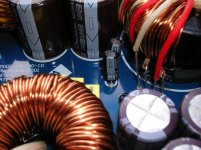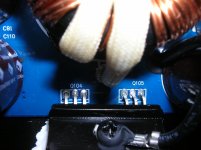Hello, I recently purchased this amp have failed.
This is what happens when you connect:
LED is lit protection, and five seconds, it shuts down and blue LED lights functioning.
So far, so good.
But when we exceed half the gain level control, comes back into protected mode.
I have reviewed tensions, and look good, but I observe, at first glance, many little tin solder (see photos) can be, because of erratic behavior?
This is what happens when you connect:
LED is lit protection, and five seconds, it shuts down and blue LED lights functioning.
So far, so good.
But when we exceed half the gain level control, comes back into protected mode.
I have reviewed tensions, and look good, but I observe, at first glance, many little tin solder (see photos) can be, because of erratic behavior?
Attachments
Last edited:
Does it go into protect simply by increasing the gain or do you have to drive a signal into it and it goes into protect when you get to a particular level of output?
Does the amp go into protect if you push on the board?
Does the amp go into protect if you push on the board?
I just come to test the amplifier, "well tested" with a car battery (I tried it yesterday when I did, with a switching power supply, these machines have the gambling halls)
Then: When connecting lights protection, takes a few seconds, you hear a click on the speaker, then it works perfectly (you can raise the level of gain control at the top and still works)
The amp I have sold as faulty.
The only detail is that, it takes a few seconds to start working .....¿ this normal?
I think I'll resolder all the solder you see poor ....
Then: When connecting lights protection, takes a few seconds, you hear a click on the speaker, then it works perfectly (you can raise the level of gain control at the top and still works)
The amp I have sold as faulty.
The only detail is that, it takes a few seconds to start working .....¿ this normal?
I think I'll resolder all the solder you see poor ....
If the amp is working, I'd suggest that you leave it as it is. The condition of the solder connection on the top of the board isn't significant on a double-sided board with plated through-holes.
Many amps have a short turn-on delay. I have no experience with this amp so I can't say what's normal for it.
Many amps have a short turn-on delay. I have no experience with this amp so I can't say what's normal for it.
Again Perry, you were right.
This afternoon, I dismounted the amplifier, and saw its other face, that the welds were fully welded.
I think I've fallen into the bad reputation of Chinese products are (in this amplifier is written in several places, "made in China "...) and for this reason, I thought, who had spared no tin in the solder ...
Then I will ride, and I will leave it as is.
I've also noticed, when I've been testing (for more than half an hour) that there has been no heating of any component, can it be that this type of amplifiers (Class D) work well?
Perry thank you very much for the advice.
This afternoon, I dismounted the amplifier, and saw its other face, that the welds were fully welded.
I think I've fallen into the bad reputation of Chinese products are (in this amplifier is written in several places, "made in China "...) and for this reason, I thought, who had spared no tin in the solder ...
Then I will ride, and I will leave it as is.
I've also noticed, when I've been testing (for more than half an hour) that there has been no heating of any component, can it be that this type of amplifiers (Class D) work well?
Perry thank you very much for the advice.
Class D amps are typically more efficient than other types of amplifiers. Most other types of amplifiers waste a lot of power which is dissipated as heat.
- Status
- Not open for further replies.
- Home
- General Interest
- Car Audio
- Rockford Fosgate PRIME R-1000-1D repairing


